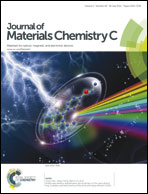Benzothiazole derivatives containing different electron acceptors exhibiting totally different data-storage performances†
Abstract
Two small conjugated molecules BTVCz–NO2 and BTVCz, each incorporating an electron-donating carbazole group and a medium electron-withdrawing benzothiazole group, were both successfully designed and synthesized. Molecule BTVCz–NO2 is an A1–D–A2 structure while BTVCz is a single D–A structure. Both molecules were made into thin films by spin-coating. The two films differentiated over their optical, electrochemical and morphological properties. And the fabricated device with BTVCz–NO2 as an active material showed non-volatile ternary WORM data-storage behavior with its switching threshold voltages at −1.5 V and −2.5 V in tandom when an electrical field was applied, whereas its “counterpart” device with BTVCz as an active material exhibited volatile binary DRAM data-storage behavior with its switching threshold voltage at −1.3 V. Combined with theoretical calculation of each molecule, we conclude that different data-storage behaviors can be achieved by introducing different electron acceptors and that molecule BTVCz–NO2, as an A1–D–A2 structure, is more likely to achieve ternary data-storage performance.


 Please wait while we load your content...
Please wait while we load your content...